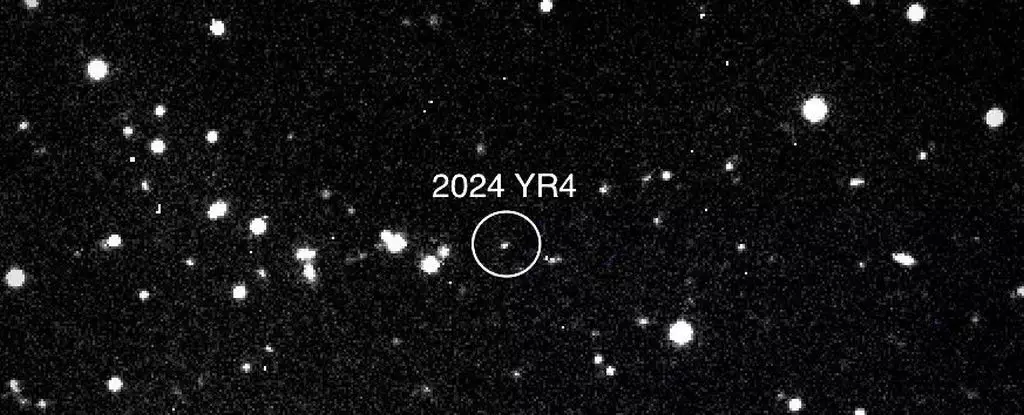Imagine staring up at the night sky, trying to unwind under the vastness of the cosmos, when news of an impending asteroid flies across headlines, sending your thoughts spiraling back to an era of anxiety and uncertainty. Such is the peculiar case of 2024 YR4, an unearthed cosmic traveler that captures the center stage of our astrological dread. Initially, its trajectory was perceived as a hazardous threat—something akin to a ‘city killer’. But as we breathe a collective sigh of relief thanks to newfound data, we find ourselves once again confronting this celestial wanderer, which refuses to vacate the headlines.
There is an undeniable thrill associated with the unknown, but with 2024 YR4, it feels more like a ticking time bomb of suspense. The good news is that a direct collision with Earth seems improbable, now marked at an impossibly low probability of just 0.001 percent. However, as our scientific curiosity grapples with uncertainty, the specter of a lunar impact lingers ominously. Recent observations hint at the moon being in the direct line of fire when 2024 YR4 swings closer in December 2032. The very thought that our celestial neighbor could face a threat rekindles the age-old fears of cosmic chaos.
The Predictions Dilemma: What Lies Ahead?
But let’s consider for a moment the implications of this peculiar asteroid in the grand scheme of scientific inquiry. As Andrew Rivkin and his team from Johns Hopkins University rightly point out, there may be a “non-zero probability” of an encounter with the Moon. Yet, here’s where the matter gets curiously convoluted. What does it mean for us? The enigmatic nature of 2024 YR4 fuels both intrigue and trepidation. Science is perpetually in pursuit of definitive answers to questions that often defy resolution.
As we await the next set of observations with the James Webb Space Telescope (JWST) slated for May 2025, the inevitability of uncertainties looms large. How do we balance our yearning for knowledge with the dangers it represents? Every calculation done to mitigate the risk of this asteroid seems to reveal a double-edged sword, shedding light on the celestial object while hinting at the moon’s potential peril.
Reevaluating Our Cosmic Vulnerability
Beyond the scientific understanding, the broader implications of 2024 YR4 touch upon our collective psyche regarding vulnerability in a cosmos that feels increasingly volatile. Here lies the irony: while we rejoice over the diminishing odds of an Earthly impact, the Moon, our closest celestial companion, stands at risk. The asteroid’s size—estimated at about 60 meters—holds equivalent power to unleash energy up to 30 megatons of TNT. That kind of energy is staggering and certainly enough to reshape landscapes, both here on Earth and on our Moon.
What does it say about our preparedness, our response mechanisms, and ultimately, our very humanity? The expansive universe, consisting of both beauty and chaos, is now within our consciousness, nudging our minds towards the more uncomfortable aspects of existence. We are no longer mere inhabitants of Earth but rather unwilling participants in a grand cosmic ballet, with asteroids as our uninvited dance partners.
The Echoes of Fear Versus Knowledge
Indeed, the unpredictability of 2024 YR4 surfaces deeper philosophical questions. Are we advancing our understanding merely to satiate our curiosity, or have we entered a new era of cosmic existentialism? The urgency of ongoing observations reflects not only a scientific commitment to unraveling the mysteries of space but also an inherent desire to confront the threats that lurk beyond our atmosphere.
This constant vigilance lays bare our fragility. Asteroids slipping through the solar system, often unnoticed, highlight the limitations of our forecasting technologies. Yet, the stagnation of cosmic uncertainty also gives rise to hope. As we scour the stars and delve deeper into understanding these celestial bodies, we inch closer to a better grasp of the enormity of the universe and its potential threats. Perhaps it is in this rigorous pursuit of knowledge that our greatest strength lies—a determination to conquer the unknown, even if it means reckoning with our vulnerabilities.
In this unfolding narrative surrounding 2024 YR4, it is essential to find a balance between trepidation and empowerment. The journey ahead is one not without challenges, but armed with knowledge and a commitment to exploration, humanity might just emerge as a worthy guardian of both our planet and our cosmic neighbors.

